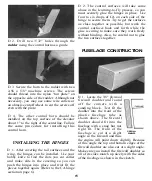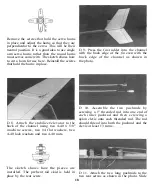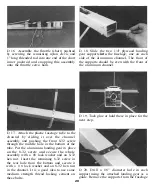
BALANCING
With the wing rubber banded to the fuselage,
the fuel tank empty and everything else in its
place, lift the model by placing one finger-tip
on the bottom of each wing at the
approximate location of each end of the wing
joiner which is 3" back from the leading edge.
The STURDY BIRDY II should hang just
slightly nose down or level. If the plane hangs
with the nose pointing up, then you will need
to add some weight to the nose of the plane.
There are several ways you can add this
weight, including stuffing lead weight around
the fuel tank or using one of the heavy prop
nuts available. U n d e r no circumstances
should you try to fly the plane if it does not
balance correctly!
GETTING READY TO FLY
D Use at least four rubber bands to hold the
engine/firewall in place and use eight #64
rubber bands to hold the wing in place.
D We recommend that you use a nylon
propeller for your first flights since it will not
break as easily as wood. Sand the edges of the
prop before you use it. The edges of nylon props
are very sharp and should be dulled before use.
If a prop is damaged in any way it should be
discarded and a new prop used in its place.
D Be sure to conduct a range test on your
radio system before every flying session. The
instruction manual that came with your
radio should explain how to properly do this.
D If you are using a new engine in your
plane, break it in on the ground according to
the m a n u f a c t u r e r ' s instructions before
attempting to fly the plane.
D Never try to start the engine by flipping it
over with your finger. Always use either an
electric starter or a "Chicken Stick."
D Always adjust the needle valve on the
engine from the back of the plane. Never reach
over a rotating prop! Treat these engines with
the utmost respect, they are not toys!
D After each flight, check the propeller,
engine bolts, control surfaces, control
linkages, hinges and r u b b e r bands for
damage or looseness and correct if
necessary. An once of prevention here will
keep you happily flying longer.
FLYING
The STURDY BIRDY II is a very stable Hying
airplane with a unique self-recovery system
designed into it. This makes it one of the
easiest flying planes available. However, it is
highly recommended that you consult an
experienced pilot to help trim out the plane
and help you with your first flights. The most
important thing to remember when learning
to fly is that you need to be able to relate to
the control inputs as if you were sitting in
the plane. If you don't, it will seem like the
rudder is working backwards when the plane
is flying towards you. It may also seem a
little strange that you pull the stick down
(back) in order to make the plane go up, but
this is how it works in real planes. It is a
good idea to keep facing the same direction
that the model is flying.
The STURDY BIRDY II should be hand
launched into the wind for your first flights.
Have a helper hold the plane firmly behind
the landing gear with the wings level while
you check the controls. Advance the throttle
to full throttle. Your helper should then take
a few running steps and let the plane fly out
of his hand with a slight push (being careful
to keep the wings level). A strong throw is not
necessary. Be prepared to make any initial
adjustments to keep the plane climbing
slightly and flying straight. Your control
inputs should be very gentle until the plane
has climbed high enough to be out of danger
23


































